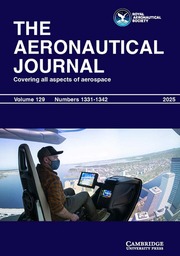Article contents
An experimental technique for accuratesimulation of the flow field forwing-in-surface-effect craft
Published online by Cambridge University Press: 04 July 2016
Summary
This paper describes a simple method to accuratelysimulate the flow field around a wing in surfaceeffect ship (Wises) model that involves the use of acontraction and a slot to suck the boundary layerfrom a flat plate. Theoretical aspects of the designare discussed with relation to the required level ofsuction and the slot width.
The effectiveness is ascertained from measurements ofthe boundary layer height on the plate throughmeasurement of the mean velocity profile and areduction in height of 50% was generally observedwhen suction was used.
Comparison of the forces on a low aspect-ratio wing,obtained from the proposed and the image method,verified the proposed method for wing heights above2·5% of the mean chord. At lower heights, separationof the boundary layer on the ground plate is thoughtto have altered the pressure distribution on thewing.
Information
- Type
- Research Article
- Information
- Copyright
- Copyright © Royal Aeronautical Society 1996
References
- 4
- Cited by

